Translated from original entry 13-09-2016
People had to wait to conquest Aiguille du Midi (3 842 meters / 12 605 feet) next to Mont Blanc by cableway until 1955, although the first concrete plans had come to light in 1905. Our subject of the following entry is a predecessor lift system, which was more an attempt, because never reached the rough peak of Aiguille du Midi due to many obstacles during the construction.
Of course, the plan seemed brave enough, because the cable transport system was in its infancy at the beginning of the twentieth century. During that period, enthusiastic engineers had been experimenting with a numerous technical solutions to build more efficient and safer cableways. For example the Wetterhorn-Aufzug in 1908, Switzerland's first aerial tramway.
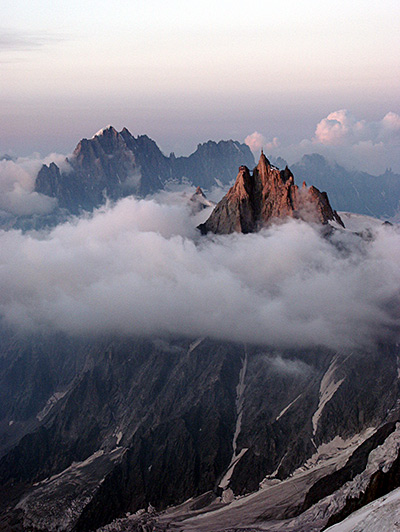
Aiguille du Midi (Wikimedia - Garrondo)
It materializated after the World War I.: the first aerial tram section between 1059 and 1690 meters (3474 and 5545 feet) above sea level was built in 1924, based on the patent plans of the Italian firm named Ceretti & Tanfani. It was led from the valley station at the district of Les Pélerins in Chamonix, to mountain station named La Para. The official handover had been timed for the winter olympic games organized there, because the new lift would have been transported the audience of the bobsleigh event to a temporary mid station. However, it was not succeed to complete till the deadline: only one of the cabin pair operated i.e. without counterbalance, that is why its transport capacity was reduced. The public at large had to wait till summer to try it out excepts personners of the olimpic games.
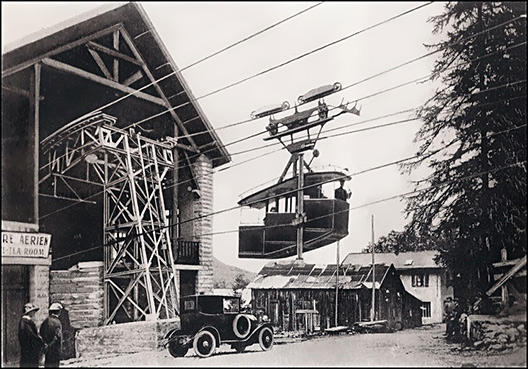
A lift started from Les Pélerins (Chamonix) valley station.
(www.remontees-mecaniques.net - Laurent Berne)
The second section La Para - Les Glaciers (1695 m - 2404 m / 5561 ft - 7887 ft), was presented 3 years after, in 1927. Tourists had been traveled with it on the one hand in the summer period admiring the huge glacier which extended as far as nearly to La Para (i.e. at mid station), but on the other hand in winter time for skiing. Soon the governors of the town and the operators realised the opportunity: ski slopes were marked out, championships were organized, a hotel and a restaurant were built at the top station, ski-rack baskets were mounted on the lift cabins for the convenient travelling.
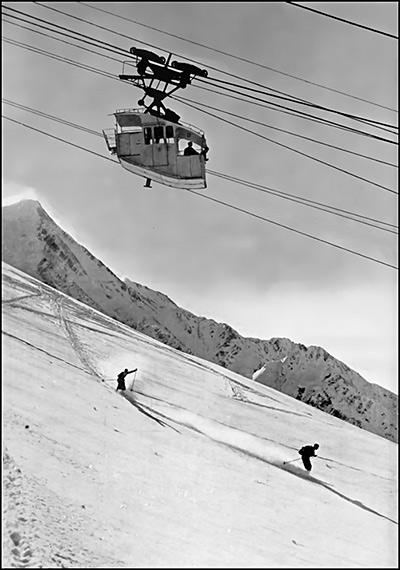
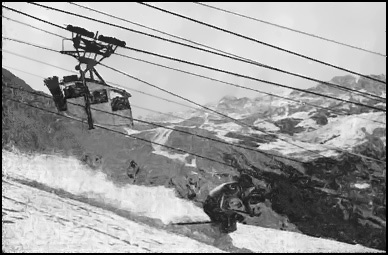
An ancient winter scene of cableways and skiing.
(www.remontees-mecaniques.net - Laurent Berne)
By the plans, the next (i.e third) stage of the whole cableway system was between Les Glaciers and Col du Midi peak (3 600 m / 11 811 ft). From that altitude, both the landscape and the weather become increasingly rough. Engineers planned cabins with big capacity, like at the other lines. That is why, it was introduced a modern system with duplicated stationary support cables, on the one hand to provide lateral stability and stand against cross-winds, on the other hand to support the whole cableway with only one lift pylon - around the middle of the line. The preparatory work was began in 1938 and the building materials and workers were transported by two temporary cargo lifts during the construction: one leaded to the ridge where the central lift pylon had been being built, the other to the peak of Col du Midi. Unlike the "classic" lift-buildings of the existing two sections, a simple concrete structure with a so called sky-touching style was dreamed for the new valley station, according to the "futurist" mood of that epoch. The lift-control buildup - which was installed on the top of the building - was quite unusual too.
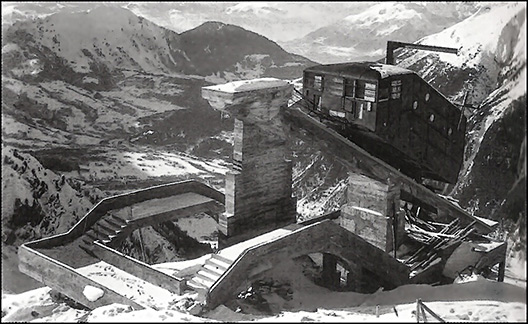
The valley station of the third section. The constructions ended to this phase. The concrete structure was almost ready: it was planned as excessively simple building without any revetment, focusing on functionality. There would have been a driving-gear and a control unit in the carriage-looking engine house which was on the 45-degree ramp. This so called carriage would have rolled back-and-forth on a rail track (fixed on the ramp) by maintaining the dynamic tensions of supporting cables. In addition to tensioning, the construction would have had safety feature: for example the frosted cables due to their extra weight would move the carriage forward, warning the controller to switch to a slower gear. The unusual structure may also be explained by the fact that the 2 kilometers / 1,24 miles long ropeway would have been supported by only one pylon, so that steel ropes would have had larger slack. (www.remontees-mecaniques.net - Monchu)
Despite the outbreak of the World War II., the working did not stop, it was almost always running, but in the last years of the warfare and the following period it slowed down considerably. Building processes stalled by the rough weather conditions, technical fiascos and serious accidents were consuming more and more money. Even the existing ropeways would have required an overall renewal, not only due to their age, but because of their technical obsolescence too. Of course they were renovated towards reliable working: for example getting modern cabins, however their transport capacity proved rather limited. In addition, after the handover tourists still could not have reached the peak of Aiguille du Midi: the fourth (i.e. last) stage had to be built for it. Thanks to these facts, engineers sketched a plan of a brand new, reconsidered and modern two-sectional cable car system, which would shuttle on a wholly new line. Unlike the incomplete predecessor lift, the new ropeway was built within a very short time and it was opened for the general public in 1955. Four years before the official handover in 1951, the old aerial tramways was closed before excursionists and skiers by local authorities for safety reasons. They were allowed only for construction tasks and were permanently shut down in 1958.
Location of lthe cable cars. Yellow line: system built in the 1920s (Les Pélerins - La Para - Les Glacier); red line: the unfinished section (Les Glaciers - Col du Midi); blue line: the two-stage lift which still has been operating today (Google Earth)
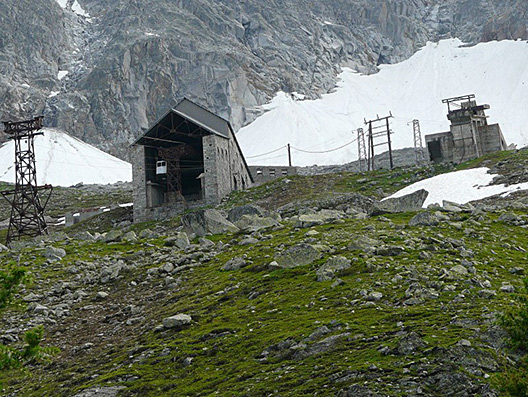
The mountain station of the second stage at Les Glaciers. The old cableway system has not been dismantled, so buildings, lift pylons and even the cabins can be found as long as they resist the natural forces (or piece of vandalism). To the right of it, the remnants of the unfinished third section seen. (www.camptocamp.org - Christian)
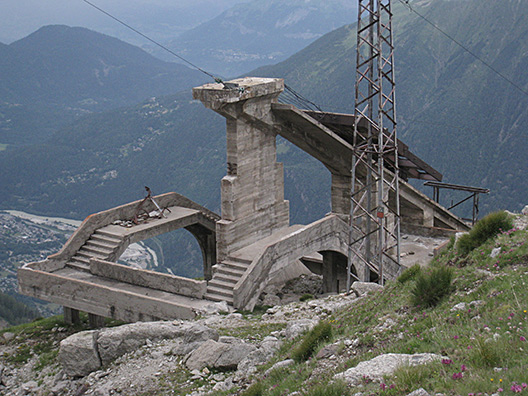
Abandoned remains of the valley station of the third stage. The abovementioned carriage-looking engine house seems to have lost in the course of time.. (www.camptocamp.org - Maria Goran)

One of the rusty lift pylons from the line between La Para and Les Glaciers. In the background, on the right side of the picture the successor cable car can be seen during the operation. (www.camptocamp.org - Christian)
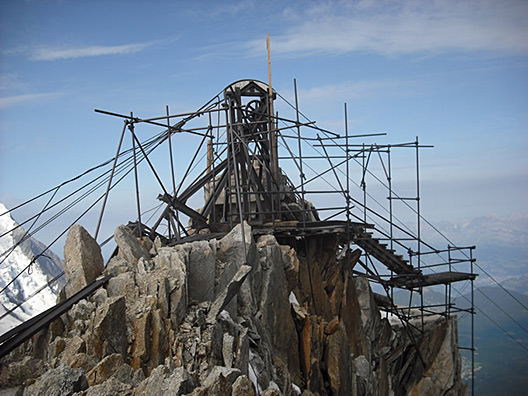
The top point of the third and unfinished stage at Col du Midi (3 600 m / 11 811 ft) in 2008. It is a miracle that scaffolding has resisted the rough weather such a long time. (www.aiguilledumidi.net)
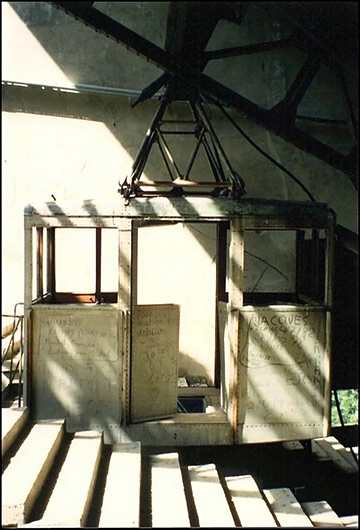
The second generation passenger unit with "decorations" at the mid station named La Para. (www.remontees-mecaniques.net - L. Berne)
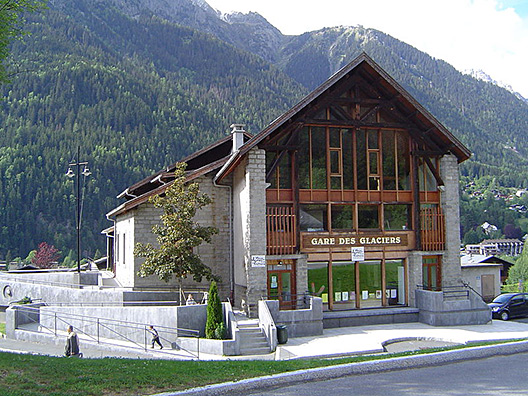
Valley station of the first stage at Les Pélerins, Chamonix, which is in the best condition. During the 2000s, it was completely renovated, commemorating the pioneers of the cable transport. The front side of the station building (from the direction of the cableway) was closed up with a glass-wall, as seen on the picture. Today its name is Gare des Glaciers and it is operated as accommodation with 5 rooms, a studio and a multi-purpose hall. (Wikimedia - AntonyB)
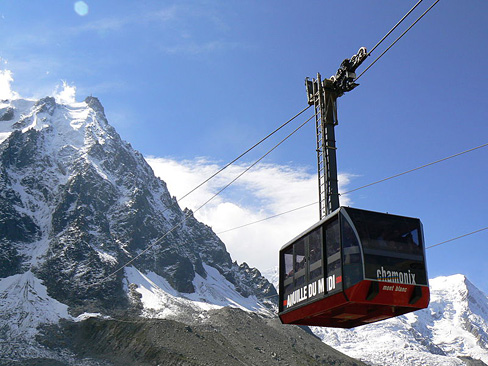
The successor cableway which finally reached the peak of Aiguille du Midi. It was put in operation in 1955 and comprehensively renovated in 1991. (Wikimédia - Clément RAOUX)
Related websites:
- http://www.remontees-mecaniques.net/bdd/reportage-tph-v-18-de-l-aiguille-du-midi-les-glaciers-ceretti-tanfani-dyle-bacalan-3869.html
- http://www.garedesglaciers.com/
- https://seclectic.wordpress.com/2014/10/05/gare-des-glaciers-and-the-original-aiguille-du-midi-cable-car/




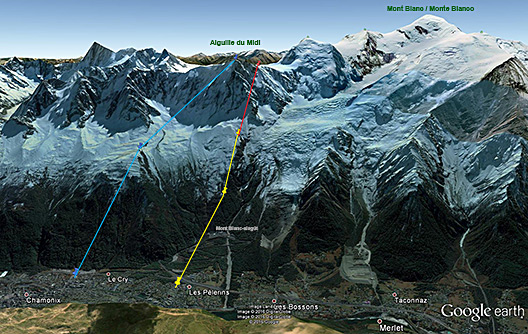
Címkék: history Aiguille du Midi Chamonix
Ajánlott bejegyzések:
Kommentek:
A hozzászólások a vonatkozó jogszabályok értelmében felhasználói tartalomnak minősülnek, értük a szolgáltatás technikai üzemeltetője semmilyen felelősséget nem vállal, azokat nem ellenőrzi. Kifogás esetén forduljon a blog szerkesztőjéhez. Részletek a Felhasználási feltételekben és az adatvédelmi tájékoztatóban.